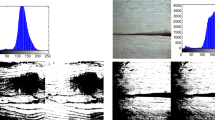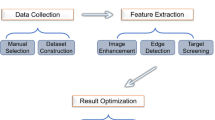Abstract
Region-Growing Algorithms (RGAs) are used to grade the quality of manufactured wood flooring. Traditional RGAs are hampered by problems of long segmentation time and low inspection accuracy caused by neighborhood search. We used morphological reconstruction with the R component to construct a novel flaw segmentation method. We initially designed two template images for low and high thresholds, and these were used for seed optimization and inflation growth, respectively. Then the extraction of the flaw skeleton from the low threshold image was realized by applying the erosion termination rules. The seeds in the flaw skeleton were optimized by the pruning method. The geodesic inflection was applied by the high threshold template to realize rapid growth of the flaw area in the floor plate, and region filling and pruning operations were applied for margin optimization. Experiments were conducted on 512×512, 256×256 and 128×128 pixel sizes, respectively. The 256×256 pixel size proved superior in time-consumption at 0.06 s with accuracy of 100%. But with the region-growing method the same process took 0.22 s with accuracy of 70%. Compared with RGA, our proposed method can realize more accurate segmentation, and the speed and accuracy of segmentation can satisfy the requirements for on-line grading of wood flooring.
Similar content being viewed by others

References
Bloch I. 2006. Spatial reasoning under imprecision using fuzzy set theory, formal logics and mathematical morphology. International Journal of Approximate Reasoning, 41(2): 77–95.
Castellani M, Rowlands H. 2009. Evolutionary artificial neural network design and training for wood veneer classification. Engineering Applications of Artificial Intelligence, 22: 732–741.
de Andrade MG, Gonzaga A. 1997. Feature extraction for defect classification in surfaces of wooden boards. Workshop on Cybernetic Vision, Proceedings — CYBVIS.
Estevez PA, Fernandez M. 1999. Selection of features for the classification of wood board defects. Artificial Neural Networks, 1999. ICANN 99. Ninth International Conference on. No. 470: 347–352.
Estevez PA, Perez CA, Caballero RE, Buhler G, Goles E. 1998. Classification of defects on wood boards based on neural networks and genetic selection of features. In: Proceedings of 4th International Conference on Information Systems, Analysis and Synthesis, ISAS’98, 1: 624–629.
Estevez PA, Perez CA, Goles E. 2003. Genetic input selection to a neural classifier for defect classification of radiata pine boards. Forest Products Journal, 53: 87–94.
Gronlund U. 1995. Quality improvements in forest products industry. Dissertation, Lulea University of Technology, Sweden.
Gu Irene Y.H. Gu, Andersson H, Vicen Renrik Andersson. 2008. Raul Vicen., Automatic classification of wood defects using support vector machines. Computer Vision and Graphics Lecture Notes in Computer Science, 5337: 356–367.
Kim CW, Koivo AJ. 1994. Hierarchical classification of surface defects on dusty wood boards. Pattern Recognition Letters, 15(7): 713–721.
Pham DT, Alcock RJ. 1998. Automated grading and defect detection: A review. Forest Products Journal, 48(4): 34–42.
Pham DT, Alcock RJ. 1999. Automated visual inspection of wood boards: selection of features for defect classification by a neural network, Proc Instn Mech Engrs Vol 213 Part E: 231–245.
Polzleitner W, Schwingshakl G. 1990. Real-time classification of wooden boards. SPIE, High-Speed Inspection Architectures, Barcoding, and Character Recognition, 1384: 38–49.
Ruz GA, Estevez PA, Ramirez PA. 2009. Automated visual inspection system for wood defect classification using computational intelligence techniques. International Journal of Systems Science, 40(2): 163–172.
Zhang QS, Song X, Shao XW, Shibasaki R, Zhao HJ. 2012. Unsupervised skeleton extraction and motion capture from 3D deformable matching. Neurocomputing, 100: 170–182.
Zheng Y, Li GY, Sun XH, Zhou XM. 2009. Fast edge integration based active contours for color images. Computers and Electrical Engineering, 35(1): 141–149.
Author information
Authors and Affiliations
Corresponding author
Additional information
Project funding: This work was financially supported by the Fundamental Research Funds for the Central Universities (DL12EB04-03), (DL13CB02), and the Natural Science Foundation of Heilongjiang Province (LC2011C25)
Rights and permissions
About this article
Cite this article
Zhang, Y., Liu, S., Cao, J. et al. A rapid, automated flaw segmentation method using morphological reconstruction to grade wood flooring. Journal of Forestry Research 25, 959–964 (2014). https://doi.org/10.1007/s11676-014-0543-1
Received:
Accepted:
Published:
Issue Date:
DOI: https://doi.org/10.1007/s11676-014-0543-1



